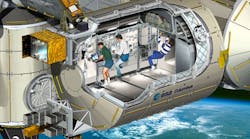The Straight Poop on Sheltering Astronauts from Cosmic Rays with Forward Osmosis
I’ve been posting photo galleries about my tour of NASA's Ames Research Center with ten winners of Littelfuse’s Speed2Design contest last August. In October, ten more winners will tour Johnson Space Center in Texas. You could be one if you follow the Speed2Design link.
One of the galleries is about some of NASA’s wind tunnels; the other is about (relatively) inexpensive experimental satellites made from cellular telephone guts.
This report doesn’t lend itself to the photo gallery treatment, so it’s mostly words. Gimmick-wise it’s about what to do with astronaut poop on the International Space Station. More seriously, it’s about the relationship NASA forges with private companies and educational institutions and how the results of those relationships bear fruit in unexpected ways.
Here’s the gist of it:
1. The bodies of people who spend a lot of time in orbit suffer in various ways. For instance, subject to microgravity, they lose muscle tone; they lose bone mass; and they undergo radiation damage from cosmic rays and high-energy particles.
(There are some interesting ways of dealing with microgravity that have been used since the early days of the U.S. space program. They rely on elastic garments that make astronaut’s muscles work harder, compensating for the lack of gravity. In fact, NASA’s Johnson Space Flight Center has been searching for volunteers for a study that involves staying in bed for a long time while wearing rubber suits. [https://bedreststudy.jsc.nasa.gov])
2. Radiation effects on the human body can’t be cannot be sufficiently attenuated by something astronauts might wear. We know that the only thing that’s going to protect astronauts is more structural mass between them and the radiation environment of space. The problem is that it costs money to launch mass. We spend millions of engineering hours eliminating mass.
3. Possible solution: astronauts spend a certain amount of time every day eliminating mass in a different sense—as fecal matter. What about using fecal matter to build up mass on the walls of the space station? Turns out, there that’s the plan. Now, if the class will stop snickering, I’ll tell you about it.
FORWARD OSMOSIS
NASA is partnering with a company called HTI Water Technology, which has commercialized a forward osmosis membrane technology.
According to HTI, forward osmosis is similar to reverse osmosis in that the process reject organics, minerals and other solids, but it avoids reverse osmosis’ fouling problems.
In forward osmosis, the permeate side of the membrane contains a salt “draw” solution which has a higher osmotic potential than the dirty stuff on the other side. That difference in osmotic potential drives the filtration process. Water molecules are forced through the membrane, leaving the impurities behind. In the process they dilute the higher concentration salt water on the permeate side making it drinkable.
This is a somewhat mature technology, in that it has been successfully commercialized. HTI originally developed forward osmosis for “cold” concentration of food and beverage products, beginning with projects at Oregon State University and The University of California at Davis. In fact, you can buy products today. Typically, these take the form of plastic sacks. At Ames, Michael Flynn, the lead of NASA’s Water Technology Development Laboratory, told the Littelfuse Speed2Design group that Forward Osmosis “Hydro Packs” are deployed at disasters like Haiti’s 2010 earthquake and distributed to U.S. troops in the field.
As Flynn described it, using a Hydro Pack is so simple it doesn’t require written instructions. You just scatter them on the ground where there may be suspect water and they will start to work. The next day, you stick a straw in the clean side and drink slightly salty water.
BACK TO THE SPACE STATION
And that’s where the story takes us back to cosmic rays on the International Space Station. As you will have deduced, if the source of the water molecules passing through the forward osmosis membrane is astronaut excreta, what remains after complete osmosis is desiccated fecal material and salts excreted by the kidneys. Mass, in other words. That is just the thing for adding radiation protection to the ISS. Food is the one thing we keep shipping to the ISS and the one thing we don’t know what to do with when the astronauts are finished with it. Here’s an elegant solution.
If that seems far-fetched, here’s a link to NASA’s description of the current state of experimentation.
BUT WAIT, THERE’S MORE!
What if you could generate electricity from the process? This part of the story isn’t for the ISS; it’s for Sustainability Base, a NASA Ames office building that is also a laboratory for testing and evaluating technologies for sustainable work and living environments on this planet and beyond.
Sponsored by a Google Inc. Green Technology Grant, the latest concept for osmotic technology is the Pressure Retarded forward Osmosis power with Tertiary Treatment, (PRO/TT). PRO/TT not only treats water, but it also generates power, as energy from the pressure differential is harvested as hydraulic power through a turbine. Don’t look for more information about it on-line though (I tried.), but it’s another of the fascinating things Littelfuse’s Speed2Design winners heard about on our tour.

